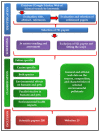Pets, Genuine Tools of Environmental Pollutant Detection
- PMID: 37760323
- PMCID: PMC10525180
- DOI: 10.3390/ani13182923
Pets, Genuine Tools of Environmental Pollutant Detection
Abstract
In a shared environment, our companion animals became unintended sentinels for pollutant exposure consequences, developing even earlier similar conditions to humans. This review focused on the human-pet cohabitation in an environment we all share. Alongside other species, canine and feline companions are veritable models in human medical research. The latency period for showing chronic exposure effects to pollutants is just a few years in them, compared to considerably more, decades in humans. Comparing the serum values of people and their companion animals can, for example, indicate the degree of poisonous lead load we are exposed to and of other substances as well. We can find 2.4 times higher perfluorochemicals from stain- and grease-proof coatings in canine companions, 23 times higher values of flame retardants in cats, and 5 times more mercury compared to the average levels tested in humans. All these represent early warning signals. Taking these into account, together with the animal welfare orientation of today's society, finding non-invasive methods to detect the degree of environmental pollution in our animals becomes paramount, alongside the need to raise awareness of the risks carried by certain chemicals we knowingly use.
Keywords: biologic contaminants; cats; chemical contaminants; dogs; environmental diseases; environmental pollution; indoor pollution; passive smoking; sentinels.
Conflict of interest statement
The authors declare no conflict of interest.
Figures
Similar articles
-
Association between indoor air pollution and respiratory disease in companion dogs and cats.J Vet Intern Med. 2018 May;32(3):1259-1267. doi: 10.1111/jvim.15143. Epub 2018 Apr 21. J Vet Intern Med. 2018. PMID: 29681128 Free PMC article.
-
Organohalogenated contaminants (OHCs) in the serum and hair of pet cats and dogs: biosentinels of indoor pollution.Sci Total Environ. 2013 Apr 1;449:29-36. doi: 10.1016/j.scitotenv.2013.01.037. Epub 2013 Feb 10. Sci Total Environ. 2013. PMID: 23403100
-
Environmental Toxic Exposures Using Companion Animals as an Indicator of Human Toxicity: A Case Report and Discussion.J Emerg Med. 2020 Jul;59(1):e1-e7. doi: 10.1016/j.jemermed.2020.04.026. Epub 2020 Jun 9. J Emerg Med. 2020. PMID: 32532580 Review.
-
Flame retardants in the serum of pet dogs and in their food.Environ Sci Technol. 2011 May 15;45(10):4602-8. doi: 10.1021/es1043529. Epub 2011 Apr 18. Environ Sci Technol. 2011. PMID: 21500827
-
Endocrine-Disrupting Chemicals and Their Effects in Pet Dogs and Cats: An Overview.Animals (Basel). 2023 Jan 22;13(3):378. doi: 10.3390/ani13030378. Animals (Basel). 2023. PMID: 36766267 Free PMC article. Review.
Cited by
-
Silicone tags as an effective method of monitoring environmental contaminant exposures in a geographically diverse sample of dogs from the Dog Aging Project.Front Vet Sci. 2024 Aug 16;11:1394061. doi: 10.3389/fvets.2024.1394061. eCollection 2024. Front Vet Sci. 2024. PMID: 39220770 Free PMC article.
-
Pollution, stress response, and obesity: A systematic review.Obes Rev. 2025 May;26(5):e13895. doi: 10.1111/obr.13895. Epub 2025 Jan 17. Obes Rev. 2025. PMID: 39825581 Free PMC article.
-
Environmental exposures and health outcomes in dogs differ according to geographic region in the United States among Dog Aging Project participants.Am J Vet Res. 2025 Jun 30:1-10. doi: 10.2460/ajvr.25.04.0121. Online ahead of print. Am J Vet Res. 2025. PMID: 40588169 Free PMC article.
-
Stress and the domestic cat: have humans accidentally created an animal mimic of neurodegeneration?Front Neurol. 2024 Jul 19;15:1429184. doi: 10.3389/fneur.2024.1429184. eCollection 2024. Front Neurol. 2024. PMID: 39099784 Free PMC article. Review.
-
Age at Tumor Diagnosis in 14,636 Canine Cases from the Pathology-Based UNIPI Animal Cancer Registry, Italy: One Size Doesn't Fit All.Vet Sci. 2024 Oct 8;11(10):485. doi: 10.3390/vetsci11100485. Vet Sci. 2024. PMID: 39453077 Free PMC article.
References
-
- Sandhu S.S., de Serres F.J. In situ evaluation of biological hazards of environmental pollutants. Mutat. Res. Environ. Mutagen. Relat. Subj. 1989;216:341–352. doi: 10.1016/0165-1161(89)90044-7. - DOI
-
- Natterson-Horowitz B., Bowers K. Zoobiquity: What Animals Can Teach Us about Health and the Science of Healing. Knopf Doubleday Publishing; New York, NY, USA: 2012. 320p.
Publication types
LinkOut - more resources
Full Text Sources
Miscellaneous





